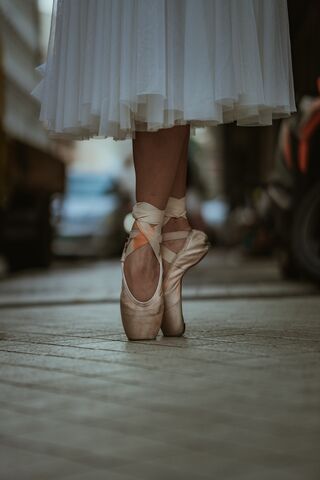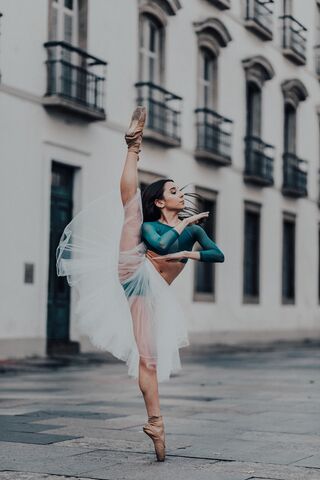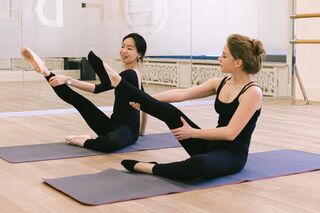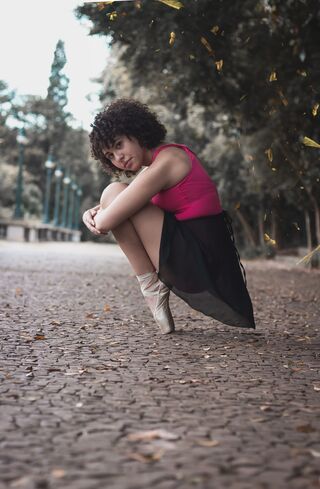Health
Is Turning Out Your Feet at the Barre a Good Glute Burner?
Longing to look like a ballerina can cause injuries.
Posted September 4, 2020
My barre class is online. This suits me very well as it saves me from having to commute to my studio during the morning rush hour traffic. All I need is a chair to substitute for the barre, and I am set. This is an unsupervised class, my teacher emphasizes, as it is not possible to see and offer advice similar to an in-person class setting. Instead, the teacher encourages us to provide feedback and ask questions via email to be addressed in the next class.
Every week someone from the class asks the teacher to clarify what causes the knee pain after class. While such pain can be a result of many things, my teacher attributes it to the pliés (knee bends) that we perform during the class. We do pliés with our feet pointing forwards (parallel 1st position in the ballet parlance), with our feet pointing to the side with our heels together (1st position), and with our feet apart with our feet pointing out (2nd position).
Our teacher emphasizes that the "turnout" (feet pointing to the side) does not need to be 90 degrees. This means that the feet are pointing entirely to the side. Instead, we should turn out to where it is still comfortable to bend the knees. This is often described as a "pizza slice" position where the feet are pointing diagonally forward.
When I search for online workouts for barre exercises in turnout, many of them advertise the turnout as an effective butt or thigh-shaping exercise. If we turn out our feet similar to ballerinas, the advertisements promise, we can feel a greater burn on both exercising legs. With this close link to ballet, I decided to find out how the turnout has traveled from ballet to barre classes. How did ballerinas begin to prefer the 90-degree turnout?

It is well established that the barre class has its roots in ballet, where the barre has traditionally served as a training tool. The origin of ballet, the way we know it now, is often traced to the court of the French king Louis XIV who, a competent dancer himself, also established a ballet school, the Académie Royale de la Danse, in 1661. Having a school devoted to dance meant the development of dance education with specific exercises for professional training.
As a starting point, the first ballet master and the director of dance at the Académie, Pierre Beauchamps, codified the five positions of ballet in the late 17th century (e.g., Astier, 1982). All five positions were performed in turnout. These are the same ones we use in barre exercise classes when we refer to the 1st position or 2nd position.
In the early days of ballet, turning the feet in was considered so "false" that it was entirely unsuitable for dance. At this point, ballet performance favored a "natural turnout" of about 45 degrees with a strong emphasis on gracefulness that was a sign of proper aristocratic comportment (Hammond & Hammond, 1979 ). This is approximately similar to what we now describe as the pizza slice position.
Although the ballet was originally performed to a limited audience of fellow courtiers, when it became a profession for trained dancers, it moved from the court to be performed in the theatres. The dancers now wanted to distinguish themselves from amateur court dancers. On stage, they exhibited increasingly difficult turns (pirouette), jumps with legs beats (entrechat), higher extensions (battement, développé), and rising to the toes. In the 19th century, ballerinas’ costumes also became lighter and more flowing with shorter dresses and soft ballet slippers. The dancers could now perform a larger range of movements that required more turned-out legs (Chazin-Bennahum, 2005).
With expanded professional training, manuals with detailed instructions for carefully coded ballet exercises began to appear. All the manuals emphasized the importance of a 90-degree turnout. For example, Carlo Blasis (1820), in his ballet manual, advocated a 90-degree turn out as an absolute necessity. “A dancer whose legs cannot turn entirely out,” he prophesized, “is never esteemed” (p. 58). He, nevertheless, emphasized that only by training from a young age can one acquire the proficiency necessary for a successful professional dancer: The legs were to be turned out from the hips, and as a result, the knees will also “turn well outwards” (p. 58).
Although Blasis’ advice appeared to target male dancers, he also celebrated the health benefits of dancing for women very much like barre exercise class advertisements today:
“Dancing is extremely useful to women, whose delicate constitutions require to be strengthened by frequent exercise, and must be serviceable in relieving them from that unhealthy inaction, to which so many of them are usually condemned” (p. 26).
The "basic exercises," performed in turnout with the assistance of the barre, that were depicted in the 19th-century ballet manuals are still performed in ballet classes today and also in our barre exercise classes. For example, the training system developed by Italian ballet master Enrico Cecchetti (Beaumont & Idzikowski, 1922) that is currently used in many ballet studios includes the same basic elements.

In the 20th century, the extreme turnout has enabled dancers to also execute greater extensions of their limbs and, thus, is a hallmark of a professional, poised, and elegant ballerina or as Phillip and Sandra Hammonds (1979) put it: “‘Unnatural’ as it [the 90-degree turnout] may be, it nevertheless allows the ballet-trained body to do what no other body can” (p. 597). After an immersion into the history of ballet, I have now learned that:
- The 90-degree turnout is not natural. It is something that one needs to train for.
- The 90-degree turnout is not to do with the feet but comes from turning the thighs outward from the hips.
- The 90-degree turnout is an integral element for professional-level ballet training, where it enables the dancers to perform their extremely demanding movement vocabulary.
Knowing all this, why do we attempt to turn our feet out excessively in an exercise class when it can clearly be achieved only through intensive ballet training? Perhaps we think a turnout reveals our inner ballerinas waiting to gain expression and, albeit anatomically entirely wrong and awkward looking, we gain the poise of a professional dancer. In a barre exercise class, where many of the ballet exercises are difficult and can easily feel more ungraceful than elegant, is pushing the feet to turn out the only feat that appears achievable?
It is also evident that forcing only the feet to turn out can cause injuries because the knees—in-between the hips and the feet—will be misaligned. Most researchers also agree that the normal external rotation of the hips (the turnout) is about 45 degrees. As we also now know, historically, the natural turnout of 45 degrees, the pizza slice position, was considered most graceful. So, not only is the pizza slice position more natural and, thus, safer, it also enables performing the barre exercises with more ease than forcefully turned-out feet.

Although barre exercise classes can include basic ballet exercises, they are also often hybrids of weight training, Pilates, yoga, and many other exercise modalities. So, do we need the turnout at all? While the turnout is the signature move of dance, do we need it for our fitness goals, such as improved strength or flexibility to counteract the stresses of our everyday sedentary lives? Is it even a good "butt burner" if such agony and pleading to stop the exercise is desirable?
Anatomically, turning out just the feet does not engage any "butt" muscles. If the thighs are turned out from the hips, it is primarily the six deep rotator muscles located roughly underneath the gluteus maximus, "the glutes," that do the work. It may be beneficial to strengthen these small muscles as they are not often used in a typical day. But it can be more beneficial, equally serious, and less injury-prone to work the gluteus maximus with one’s feet facing forward in a parallel position.

If everything is performed in parallel, we may lose the aspect that makes a barre class unique: the flair of dance. The pizza slice turnout is a safer option for exercisers longing for a touch of ballet in their classes. However, even this natural turnout is challenging as it requires coordinating hip turnout with proper leg alignment.
As a strong element of contemporary dance, including contemporary ballet, we can look equally "dancy" and exercise with fewer injuries, when pliéing, relevéing, or extending in parallel. Moreover, not all barre class devotees are partial to dance, and thus, exercising in parallel can provide a safe and effective option for everyone who now workouts at home unsupervised by a qualified teacher.
References
Astier, R. (1982). Pierre Beauchamps and the ballets de collège, Dance Chronicle, 6(2), 138-163.
Beaumont, C. W., & Idzikowski, S. (1922). A manual of the theory and practice of classical theatrical dancing (Methode Cecchetti). London: CW Beaumont.
Blasis, C. (1828/1830). The code of Terpsichore: The art of dancing (trans. R. Barton). London: Edward Bull.
https://www.libraryofdance.org/manuals/1830-Blasis-Code_(Goog).pdf
Chazin-Bennahum, J. (2005). The lure of perfection: Fashion and ballet, 1780-1830. London, UK: Psychology Press.
Hammond, P. E., & Hammond, S. N. (1979). The internal logic of dance: A Weberian perspective on the history of ballet. Journal of Social History, 12(4), 591-608.
Theleur, E. A. (1831). Letters on Dancing, reducing This elegant and healthful exercise to easy scientific principles. London, UK.




